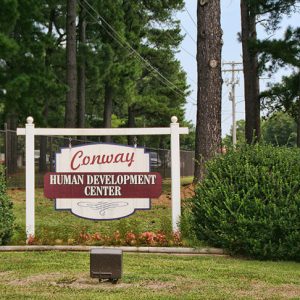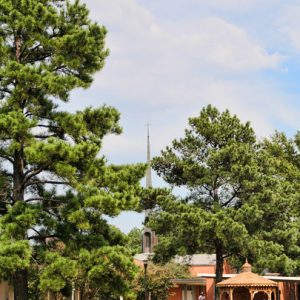calsfoundation@cals.org
Arkansas Children's Colony
aka: Conway Human Development Center
Dedicated on October 4, 1959, the Arkansas Children’s Colony was a state-supported center that served Arkansas’s mentally handicapped children. The colony, set on a little over 400 donated acres in Conway (Faulkner County), provided a school and a home away from home for as many as 1,000 developmentally disabled, school age children.
Governor Orval Faubus lobbied strongly for funds to build a facility to serve the state’s mentally challenged children. On January 25, 1955, the Arkansas General Assembly created Act 6, which engendered Arkansas’s first facility to serve such children. Arkansas was the forty-eighth state to open such an institution. A donation of $1,200 was made to the facility, and workers began construction in 1958. Less than two years later, 3,000 people attended the facility’s opening.
The Arkansas Children’s Colony was a full residential facility with numerous cottages, classrooms, a gym, a kitchen, a health clinic, and a chapel. Its central location eventually allowed much of the state to benefit from the services offered.
In the facility’s early days, the cottages housed 256 residents, and by the early 1970s, more cottages had been built to accommodate over 1,000. At one time, the waiting list for the colony numbered 1,800 children.
Sponsoring the facility were the Kiwanis Clubs of Arkansas. Their work helped fund the building of the non-denominational chapel on the grounds in 1968. The Arkansas Federation of Women’s Clubs (AFWC) soon adopted the colony as a special project, raising $18,000, some of which helped purchase playground equipment for the first six cottages. Another part of the funds helped in the building of the chapel on the colony’s grounds, including the stained-glass windows.
Other groups playing key roles were the United Commercial Travelers of Arkansas, the Little Rock (Pulaski County) chapter of the National Association of Railway Business Women, and the Elks Clubs of Arkansas. In addition, the Civitan, Optimist, Rotary, and Lions clubs donated time, money, and necessities.
This children’s compound was greatly needed in Arkansas. Not only did it serve the state’s mentally challenged children, but later it housed ill children. Sufferers of German measles stayed there between the years of 1963 and 1965. Easy isolation was a plus in using the colony for vaccine research. Each cottage housed sixteen patients, and physicians tested the German measles vaccine on many of the children, with their parents’ approval. These young residents proved invaluable to the research, which ushered in common use of the current rubella vaccine.
On the evening of April 10, 1965, a devastating tornado tore a path through Conway. The twister killed six area residents, but none of the colony’s children were harmed. Unfortunately, damage to the children’s living quarters left the displaced youths confused and frightened. Nearby Hendrix College came to the rescue and housed some of the children until their parents arrived.
Eventually, numerous statutes expanded Act 6, and legislation in 1971 broadened the definition of those accepted at the colony to include children with certain physical maladies and disorders that caused the patients to struggle in performing daily routines. These included autism, cerebral palsy, and epilepsy.
In 1981, the Arkansas Children’s Colony was renamed as the Conway Human Development Center (CHDC) and continues under that name. Since the Conway location was a success, five other such human development centers (HDCs) opened around the state. These were located in Arkadelphia (Clark County), Alexander (Pulaski and Saline counties), Jonesboro (Craighead County), Booneville (Logan County), and Warren (Bradley County). The Warren facility was the most recent to open, beginning operations in 1978. The Alexander facility closed in 2011.
By the beginning of the twenty-first century, Arkansas had one of the highest percentages of individuals with disabilities living in institutions among the fifty states. CHDC director Bob Clark resigned in 2002 after serving more than twenty years in that position. That year, CDHC was troubled by lawsuits from families of residents, by state and federal investigations, and by a series of unfavorable articles in the Arkansas Democrat-Gazette. The institution was accused of neglect and abuse of residents, including lack of proper medical care, improper supervision of residents who were harming other residents, abusive behavior toward residents by staff members, and failure to report a variety of problems. Continued investigations led to a fifty-page report issued by the U.S. government in 2004 in which the center was described as “terribly inadequate” and “grossly deficient.” Attorneys for the federal agencies and for the State of Arkansas began years of meetings seeking to resolve the legal troubles of CHDC. In January 2009, the U.S. Department of Justice filed suit against the Conway Human Development Center, alleging improper care of the residents. The suit went to trial in September 2010 but was dismissed in early 2011.
The HDCs still offer a residence and provide for habilitative and medical care for qualifying children, but by 2009, most of the approximately 500 residents of Conway Human Development Center were adults. Each of Arkansas’s seventy-five counties benefits from community-based services—some through nonprofit, private programs.
For additional information:
Arkansas Children’s Colony. Vertical File. Special Collections. University of Arkansas Libraries, Fayetteville, Arkansas.
Division of Developmental Disabilities Services. Arkansas Department of Human Services. https://humanservices.arkansas.gov/about-dhs/ddds (accessed August 31, 2022).
Shores, Elizabeth F. “Background for the Establishment of the Arkansas Children’s Colony.” Faulkner Facts and Fiddlings 38 (Fall/Winter 1996): 48–50.
———. Driving to Timbuktu: The Movement for Developmental Disabilities Services in Arkansas, 1944–1975. Little Rock: Center for Arkansas Studies, University of Arkansas at Little Rock, 2005.
Teague, Betty R. “The Site Decision for the Arkansas Children’s Colony.” Faulkner Facts and Fiddlings 37 (Spring/Summer 1995): 1–11.
Wyre, Dorothy Otis. “The Children’s Colony.” Arkansas Gazette, May 8, 1960, p. 2E.
Lea Milford
Fayetteville, Arkansas
 Conway Human Development Center Entrance
Conway Human Development Center Entrance  Conway Human Development Center Chapel
Conway Human Development Center Chapel 




Comments
No comments on this entry yet.